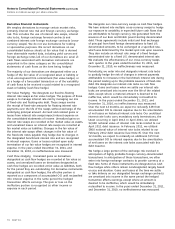AT&T Wireless 2011 Annual Report Download - page 76
Download and view the complete annual report
Please find page 76 of the 2011 AT&T Wireless annual report below. You can navigate through the pages in the report by either clicking on the pages listed below, or by using the keyword search tool below to find specific information within the annual report.
Notes to Consolidated Financial Statements (continued)
Dollars in millions except per share amounts
74 AT&T Inc.
We designate our cross-currency swaps as cash flow hedges.
We have entered into multiple cross-currency swaps to hedge
our exposure to variability in expected future cash flows that
are attributable to foreign currency risk generated from the
issuance of our Euro and British pound sterling denominated
debt. These agreements include initial and final exchanges
of principal from fixed foreign denominations to fixed U.S.
denominated amounts, to be exchanged at a specified rate,
which was determined by the market spot rate upon issuance.
They also include an interest rate swap of a fixed foreign-
denominated rate to a fixed U.S. denominated interest rate.
We evaluate the effectiveness of our cross-currency swaps
each quarter. In the years ended December 31, 2011, and
December 31, 2010, no ineffectiveness was measured.
Periodically, we enter into and designate interest rate locks
to partially hedge the risk of changes in interest payments
attributable to increases in the benchmark interest rate during
the period leading up to the probable issuance of fixed-rate
debt. We designate our interest rate locks as cash flow
hedges. Gains and losses when we settle our interest rate
locks are amortized into income over the life of the related
debt, except where a material amount is deemed to be
ineffective, which would be immediately reclassified to
income. In the years ended December 31, 2011, and
December 31, 2010, no ineffectiveness was measured.
Over the next 12 months, we expect to reclassify $28 from
accumulated OCI to interest expense due to the amortization
of net losses on historical interest rate locks. Our unutilized
interest rate locks carry mandatory early terminations, the
latest occurring in April 2012. In April 2011, we utilized
$2,600 notional value of interest rate locks related to our
April 2011 debt issuance. In February 2012, we utilized
$800 notional value of interest rate locks related to our
February 2012 debt issuance (see Note 8). Over the next
12 months, we expect to reclassify an additional $15 from
accumulated OCI to interest expense due to the amortization
of net losses on the interest rate locks associated with this
debt issuance.
We hedge a large portion of the exchange risk involved in
anticipation of highly probable foreign currency-denominated
transactions. In anticipation of these transactions, we often
enter into foreign exchange contracts to provide currency at a
fixed rate. Some of these instruments are designated as cash
flow hedges while others remain nondesignated, largely based
on size and duration. Gains and losses at the time we settle
or take delivery on our designated foreign exchange contracts
are amortized into income in the same period the hedged
transaction affects earnings, except where an amount is
deemed to be ineffective, which would be immediately
reclassified to income. In the years ended December 31, 2011,
and December 31, 2010, no ineffectiveness was measured.
Derivative Financial Instruments
We employ derivatives to manage certain market risks,
primarily interest rate risk and foreign currency exchange
risk. This includes the use of interest rate swaps, interest
rate locks, foreign exchange forward contracts and
combined interest rate foreign exchange contracts (cross-
currency swaps). We do not use derivatives for trading
or speculative purposes. We record derivatives on our
consolidated balance sheets at fair value that is derived
from observable market data, including yield curves and
foreign exchange rates (all of our derivatives are Level 2).
Cash flows associated with derivative instruments are
presented in the same category on the consolidated
statements of cash flows as the item being hedged.
The majority of our derivatives are designated either as a
hedge of the fair value of a recognized asset or liability or
of an unrecognized firm commitment (fair value hedge), or
as a hedge of a forecasted transaction or of the variability
of cash flows to be received or paid related to a recognized
asset or liability (cash flow hedge).
Fair Value Hedging We designate our fixed-to-floating
interest rate swaps as fair value hedges. The purpose of these
swaps is to manage interest rate risk by managing our mix
of fixed-rate and floating-rate debt. These swaps involve
the receipt of fixed-rate amounts for floating interest rate
payments over the life of the swaps without exchange of the
underlying principal amount. Accrued and realized gains or
losses from interest rate swaps impact interest expense on
the consolidated statements of income. Unrealized gains on
interest rate swaps are recorded at fair market value as assets,
and unrealized losses on interest rate swaps are recorded at
fair market value as liabilities. Changes in the fair value of
the interest rate swaps offset changes in the fair value of
the fixed-rate notes payable they hedge due to changes in
the designated benchmark interest rate and are recognized
in interest expense. Gains or losses realized upon early
termination of our fair value hedges are recognized in interest
expense. In the years ended December 31, 2011, and
December 31, 2010, no ineffectiveness was measured.
Cash Flow Hedging Unrealized gains on derivatives
designated as cash flow hedges are recorded at fair value as
assets, and unrealized losses on derivatives designated as
cash flow hedges are recorded at fair value as liabilities, both
for the period they are outstanding. For derivative instruments
designated as cash flow hedges, the effective portion is
reported as a component of accumulated OCI until reclassified
into interest expense in the same period the hedged
transaction affects earnings. The gain or loss on the
ineffective portion is recognized as other income or
expense in each period.
























